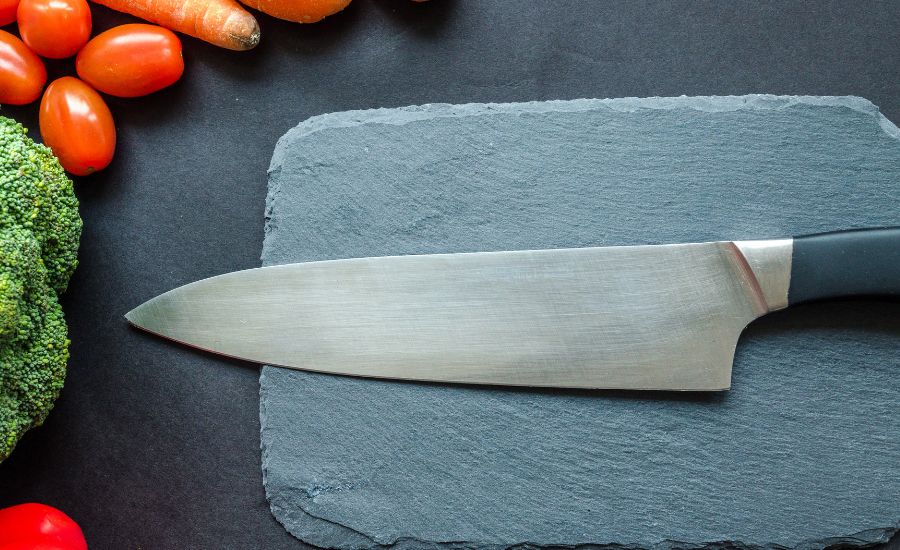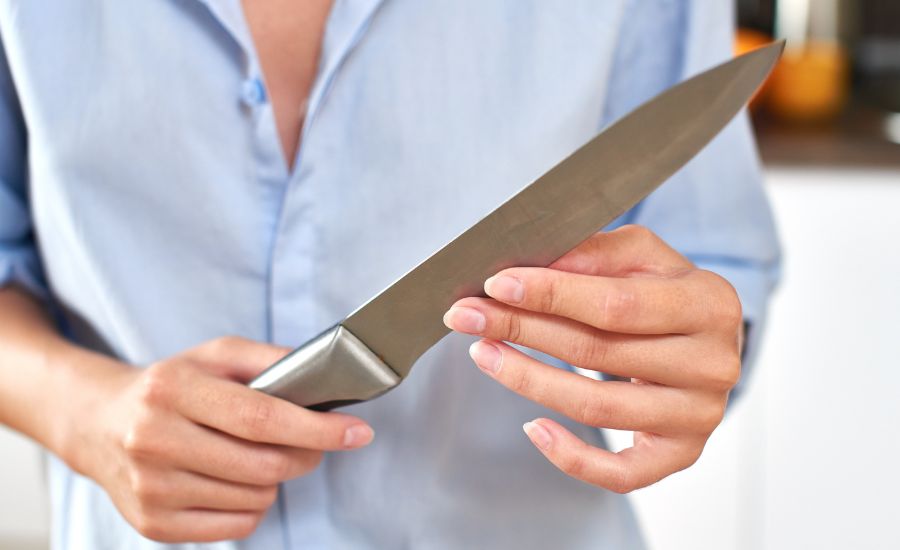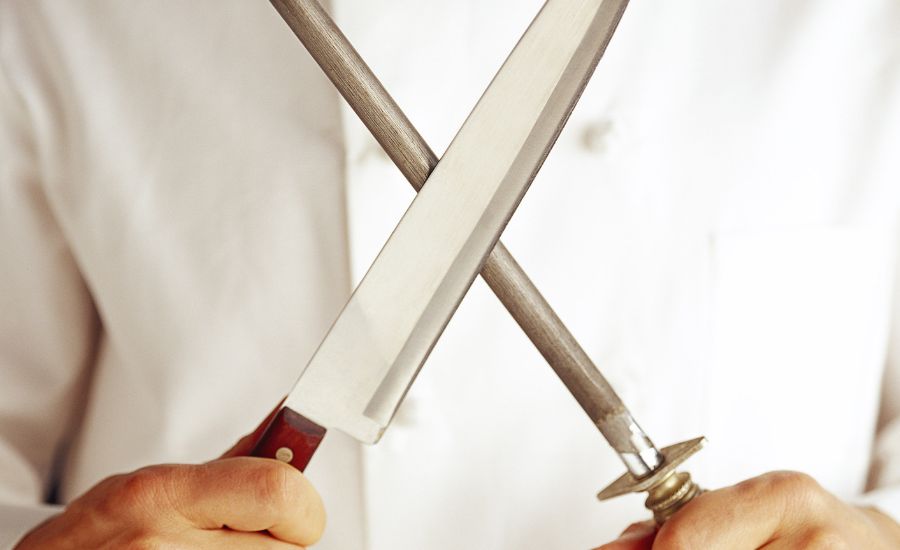The steel used in any craft makes the difference between an amazing result and an average one, the 1075 and 1095 steels are strong competitors in this field, like the famous Damascus steel, these high-carbon steels, which are both admired for their distinctive qualities, have spurred ongoing arguments on which one is generally better.
The fact that both steels are known for their outstanding hardness and wear resistance, and also belong to the same category of steels, gives them a significant advantage.

Beyond this common foundation, they diverge into separate realms of performance, making their comparison an engaging one for those looking for the perfect blade.
We’ll examine the features, characteristics, and differences of both steels in this article, exploring “1075 vs. 1095 steel”.
Contents
1075 steel: overview
1075 steel is a high-carbon steel alloy characterized by its carbon content, which ranges from 0.70% to 0.80%, it belongs to the class of plain carbon steels, which means it contains no important alloying elements besides carbon.
Due to its unique composition, it has exceptional hardness, strength, and wear resistance, making it suitable for a variety of demanding applications.
While 1075 steel is not as tough as some other steels with less carbon, it, however, has enough toughness to handle a variety of impacts.
This and its wear resistance and hardness make it strong and resilient.
The wear resistance of the steel is due to its high carbon content, ensuring that the steel can endure extended usage without losing its edge or structural integrity.
The steel is a wonderful material for making knives, machetes, and other cutting tools due to its amazing hardness and good wear resistance, the 1075 is often compared to Damascus steel and is used in making springs, such as those found in machinery, automotive components, and various mechanical applications.
1095 steel: overview
1095 steel is a high-carbon steel that also belongs to the “plain carbon steel” family, it belongs to the category of carbon-rich steels because of the average range of its carbon content between 0.90% and 1.03%.
Because of its higher carbon content, 1095 steel has an unmatched hardness, wear resistance, and better edge retention, making it a popular steel for knife manufacturing industries.
The historical significance of 1095 steel is interwoven with the evolution of steelmaking and the advancement of metallurgy, blacksmiths, and craftsmen have experimented with various iron compositions over the years, gradually refining their knowledge of the qualities of the steel.
Using the right methods and materials, 1095 steel is surprisingly very simple to sharpen despite its exceptional hardness, 1095 blades can be easily sharpened or filed by users thanks to this.
Woodworkers like the fact that it is a sharp and wear-resistant steel because this makes it perfect for making chisels, plane blades, and other woodworking tools alike.

Physical properties: 1075 vs. 1095 steel
The physical features of steel play a critical role in determining its performance and suitability for different applications.
The density of 1075 steel is approximately 7.85 grams per cubic centimeter, it is relatively dense and has a significant weight thanks to its composition, which makes it a perfect tool steel.
The 1095 steel has a density similar to 1075 steel, they also share equal weight per volume, and both steels have the same densities due to their high carbon content.
1075 steel is known generally as hard steel, it has a hardness rating of 52–59 HRC, this hardness makes it a preferred option when making a knife blade.
The 1095 steel has a hardness range of 57-59 HRC, the quantity of carbon present is the main factor affecting its outstanding hardness, granting knives and blades made from it remarkable edge retention.
Both steels offer extraordinary magnetism compared to steels with a lesser amount of carbon, making them suitable for any work that steels with brilliant magnetic properties are required.
Compared to some high-alloy steels, 1075 steel has excellent machinability that makes shaping and forming easier.
However, its hardness requires appropriate tooling and cutting parameters to achieve desired results.
Chemical composition: 1075 vs. 1095 steel
The chemical composition of the alloys are alike but are not completely the same, these distinctions are explained below
Iron
The base element of the two steels is iron, which is also the main element in both of them. The structure and chemical properties of steel are formed by the interaction of various components on an iron matrix, unlike lower carbon steels, these steels are primarily composed of iron, which serves as the base upon which other elements interact.
Carbon content
The high carbon content of 1075 steel is what makes it a high carbon steel, its carbon content, which ranges from 0.70% to 0.80% is its key distinguishing characteristic, this gives it a significant amount of hardness, making it the perfect tool steel.
1095 steel is also a high carbon steel distinguished by its exceptionally high carbon content that ranges from 0.90% to 1.03%, the difference in their carbon content is one of the major differences in the two high carbon steels.
Manganese
1075 steel contains a moderate amount of manganese, often between 0.45% and 0.95%, manganese acts as a deoxidizer and contributes to grain refinement, improving the steel’s strength and lifespan.
1095 steel has a reduced manganese content between 0.30% and 0.50%, which in the high carbon steels is to focus on maximizing carbon content, as manganese can reduce carbon availability during the steel manufacturing process.
Silicon
The silicon content of 1075 is generally around 0.16% to 0.36%, it serves as a deoxidizer and also enhances the steel’s hardness.
1095 steel contains little silicon, around 0.16% to 0.28%, to aid in deoxidization and improve strength.
Impurities (Phosphorus and Sulphur)
These elements are considered impurities in steel and are kept at low levels in both 1075 and 1095 steel to maintain the material’s quality and workability.
Both steels maintain low levels of impurities to ensure high quality with good workability.
Availability and price
Steel prices and availability can vary regionally because of factors such as production capacity, transportation costs, and regional demand. Because of decreased transport expenses, certain regions with greater steel production capability may offer lower prices.
Several other factors, such as the price of raw materials, production costs, and consumer demand impact steel prices, as a result, the specific prices change from time to time.
Since 1075 has a lower carbon content and lower production costs than 1095 steel, it is generally cheaper, it provides a cost-effective option for those seeking high-carbon steel with good performance and versatility.
1095 steel is generally pricier than 1075 steel because of its higher carbon content and better blade retention, due to the unmatched sharpness and durability it delivers, custom knife makers are prepared to pay a greater price for high-performance knife-making steels.
The two steels are widely available on the market, serving various uses and countless industries, while 1095 steel has a higher price thanks to its superior blade retention and performance, 1075 steel is more cost-effective because it has less carbon and reduced production expenses.

Toughness and corrosion resistance
1075 steel exhibits moderate toughness, the element it is made up of strikes a balance between hardness and toughness, making it a perfect knife steel. 1095 steel may exhibit lower toughness compared to 1075, the increased carbon concentration contributes to its exceptional hardness but can also reduce its ability to absorb much impact.
1095 steel is generally known as a good knife steel because knives produced with 1095 steel can maintain an extremely sharp edge for a long time, but they may be prone to fracturing and chipping after prolonged usage.
1075 steel is a plain carbon steel that isn’t particularly made to have a high level of corrosion resistance, it may rust when exposed to dampness and extreme situations, but corrosion can be avoided by properly maintaining it and performing activities such as regular cleaning, oiling, and proper storage of blades and tools.
1095 steel also lacks alloying elements that boost corrosion resistance, regular care and maintenance are also required because they are likely to rust after a long period.
In some applications, coatings or surface treatments may be used to prevent low corrosion resistance.
The carbon content and lack of special alloying components for corrosion resistance affect the corrosion resistance of both steels, the balance of hardness and toughness in both steels makes both of them good tool steel.
Blade retention
The hardness of 1075 steel ranges from 49-59 HR, while this ensures good edge retention for general-purpose knife blades, it might not retain its edge as long as the 1095 steel.
The greater edge stability and lifespan of 1095 steel are attributed to its hardness range, this reduces the need for frequent re-sharpening and enables knives and blades made with 1095 steel to maintain their sharpness even after a long time.
The balance of hardness and toughness in 1075 steel makes it perfect for applications where a fine edge and moderate toughness are essential, because of this, it may be used with a variety of knives and cutting instruments.
Despite having excellent edge retention, 1095 steel can be less durable than 1075 steel because of its higher carbon content, as a result, it is perfect for applications where edge retention is a priority.
The versatility and superior blade retention of both steels make them great materials for a variety of cutting instruments and knives, making them top choices for applications where edge retention is a priority.
Heat treatment
After hardening, steel becomes too brittle to be useful; therefore, tempering is done to slightly reduce hardness while boosting toughness and lowering the chances of brittleness.
Depending on the desired toughness, the temperature at which 1075 steel will be heat treated generally ranges from 392 °F to 752 °F (200 °C to 400 °C), lower tempering temperatures may result in higher hardness but reduced toughness.
The same procedure is followed to heat-treat 1095 steel, but due to its higher carbon content, tempering temperatures are often on the lower end of the range, around 392 °F to 572 °F (200 °C to 300 °C), as a result of heat treatment, it gains an increased level of toughness which makes it a very hard steel.
When heat-treated properly, steels achieve good toughness and strength, making them appropriate for countless uses like making knife blades and other tools.
Their wear resistance and edge retention are also improved thanks to heat treatment processes, after being heat treated, their carbon potential is maximized, allowing them to achieve one of the highest hardness levels among carbon steels.
Application: 1075 vs. 1095 steel
Spring: Both steels are perfect in spring production, like flat springs and clock springs, they can withstand stress and deformation while maintaining their shape and performance, which is the main feature of good spring steel.
Handmade knives: The availability and balanced performance of the steels make them preferred by blacksmiths and knife makers like Buck knives, Lee knives, and Cold Steel for creating custom knives.
Industrial application: They are also used to create industrial blades and saw blades in some industrial applications, their hardness, and wear resistance make them good tool steels, it is also commonly used to manufacture steel arms.
Collectible knives: Collectors and knife makers value the unique properties of 1095 steel, it’s loved for its better edge retention and exceptional cutting performance.
Cutting implements: High-end cutting tools used in professional kitchens are typically made of 1095 steel because the steel can maintain a sharp edge for extended periods.
Maintenance tips
Regular cleaning: After usage, thoroughly wash the steel blades or tools with warm, soapy water to get rid of any residues, dirt, or dust, avoid using harsh chemicals or abrasive pads that could scratch the surface of the steel.
Storage: Steel knives should be kept dry and well-ventilated, avoid leaving them in damp environments for extended periods, as moisture can lead to rust formation.
Sharpening: Regularly sharpen the blades using appropriate sharpening stones or tools, sharp edges that are properly maintained provide better cutting performance and require less effort to operate.
Oiling: Regularly coat the blade with knife oil, to keep it dry and increase its lifespan and resistance to corrosion.
Drying: After cleaning, make sure to dry the steel completely with a soft cloth to prevent moisture from causing rust or corrosion.

FAQ
What’s the difference between 1095 and 1075 steel?
The major difference between the two steels is their carbon content, which impacts their chemical properties.
Is 1075 high carbon steel quality?
1075 steel is considered high-carbon steel and is widely used because of its exceptional performance in various applications.
What steel is better than 1095?
Some consider 1095 the best steel while others consider several steels better than 1095, some examples of these steels are S30V steel, VG10 steel, and M390 steel.
What grade is 1095 steel equivalent to?
1095 steel belongs to the 10xx series of carbon steels, it is very popular and widely used for various purposes.
Conclusion
Both 1075 steel and 1095 steel are good carbon steels with distinct properties, with 1095 steel being loved for superior edge retention, and 1075 steel being preferred for its balanced performance and versatility.
Using this article as a guide, the choice between the two steels depends on the specific needs of the application.


